Contents
The contribution of cement industry in the economic development of Pakistan
Preface:
Thanks to Almighty Allah to Whom all praise and gratitude is due. Without His help none of us
can attain our goals, no matter how hard we try and what means we use. It is because of His
blessings that we sustain all ordeals and get solace after sorrows. We are grateful to Him for
giving us strength and energy to not only undertake this task but also complete it. We would also
like to grab this opportunity to thank our Faculty In-charge, Sir Yasir Ali, whose persistent
support and essential help throughout this dissertation has enabled us to submit it in time.
Without his continuous guidance, we would never have accomplished this task. The group
worked in coordination with each other which resulted in the production of this report.
The research report is an in depth and exploratory study on “The Contribution of Cement
Sector in Pakistan”. The report an executive summary, glossary of terms, statement of the
problem, hypothesis, scope of study, methodology, review of literature, the main discourse of our
analysis followed by SWOT analysis and recommendations.
There were certain limitations the group faced while conducting the research due to the paucity
of time and the short duration of the Specialized Training Program due to which primary data
could not be consulted. However, with the cooperation of the group members and consistent
teamwork were able to turn out a research paper which gave us an opportunity to have an in
depth knowledge of the cement sector in Pakistan.
Executive Summary:
The Cement sector of Pakistan which was more or less showing an increasing trend from last few
decades is unfortunately posing a decline from last few years. Many things, variables and aspects
have contributed to the negative trend of its growth. A holistic view of cement sector in totality
could have given many different pictures but given are localized view to the economic growth of
the sector; we found out that it has suffered a lot. The economic situation also exacerbated,
collectively resulting in decline of production and exports. The analysis of this sector from
various perspectives through our research and consultation of available research verified and to
some extent endorsed the causes which were sorted out and listed down in the literature review
by the group. These causes are high cost of energy, heavy taxation, high freight charge, low
spending upon PSDP, fluctuating interest rates, declining international market share political
instability, law and order situation, economic constraints to retrieve back to original situation and
international market competitiveness. Looking into all major causes, recommendations are given
in way forward which is to the best of our understanding and capacity for the Cement Sector.
Glossary of Terms:
FDI: Foreign Direct Investment
FY; Fiscal Year
GDP: Gross Domestic Product
PSDP: Public Sector Development Program
SBP: State Bank of Pakistan
CAGR: Capacity growth rate (CAGR
Clinker In the manufacture of Portland cement, clinker is lumps or nodules, usually 3-
25mm in diameter, produced by sintering limestone and alumino-silicate during
the cement kiln stage
Pre-homogenization
the initial homogenization of raw materials, so that raw materials yard has the
functions of storage and homogenization at the same time during the process of
the retention of raw materials.
Raw meal: Massive quantities of raw materials that have been crushed and ground to
produce clinker.
Pyro-processing:
is a process in which materials are subjected to high temperatures (typically over
800°C) in order to bring about a chemical or physical change.
Fly Ash: is one of the residues generated in combustion, and comprises the fine particles that rise with the flue gases
Slag: a by-product of metal smelting
Lime mud: Lime mud is a byproduct of the papermaking industry with a calcium carbonate equivalency similar to dolomitic limestone
Slurry: A mixture of cement and water to form concrete
Calcination: (also referred to as calcining) is a thermal treatment process in presence of air
applied to ores and other solid materials to bring about a thermal decomposition
Silos: A silo is a structure for storing bulk materials.
Ball mills: A ball mill is a type of grinder used to grind materials into extremely fine powder
for use in mineral dressing processes, paints, pyrotechnics, and ceramics.
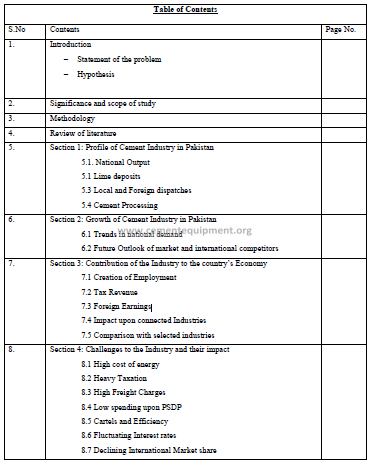
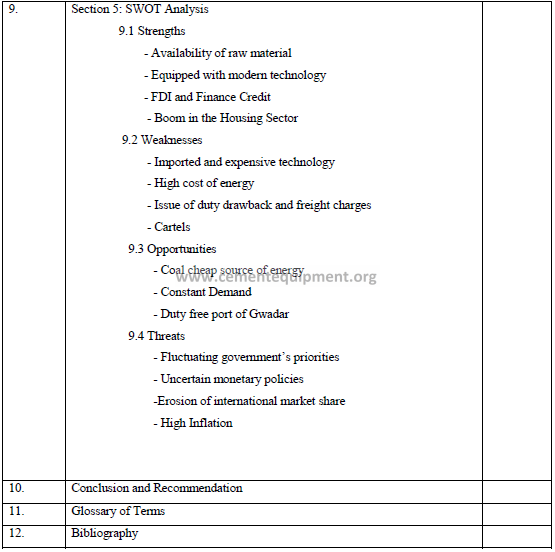
STATEMENT OF THE PROBLEM :
This study is to determine the effects of challenges faced by cement industry to the positive
contribution of cement industry in development of Pakistan.
HYPOTHESIS:
The contribution of cement industry in development of the country is negatively affected by the
challenges it is facing.
Significance and Scope of the Study:
The purpose of research will be to analyze the potential problems concerning the cement sector
and the factors affecting its positive contribution in the economic development of Pakistan. The
research will zero in on the bottlenecks hindering this sector in realizing its true potential.
The methods employed in this study is to critically assess the impact of the challenges being
faced by the cement sector, its role in the positive contribution to Pakistan’s economy and based
on this evaluation conduct an analysis gauging its strong points, limitations, opportunities and
the threats posed to it.
The study will delineate the workable strategies to overcome the multifarious challenges.
Methodology
Research methodology requires gathering relevant data from the specified documents and
compiling databases in order to analyze the material and arrive at a more complete understanding
of the shortcomings the Cement Sector in Pakistan
This research paper will utilize both quantitative and qualitative data collection tools. The
empirical material shall be qualitatively analyzed in order to reach the logical conclusion on the
research topic.
Data shall be collected from the standard research conducted on the Cement sector. Research
articles and treatises shall also be used for the data collection purposes. There shall be the
application of internet websites on the research topic.
Qualitative evaluation shall be utilized for this research paper leveraging subjective methods
such as observations to collect substantive and relevant data. Upon collecting the qualitative data
derived, careful analysis shall be done.
Literature Review
The cement industry in Pakistan has come a long way since independence when the country had
less than half a million tones per annum production capacity. Privatization and effective price
decontrol in 1991-92 heralded a new era in which the industry had reached a level where surplus
production was achieved after meeting local demand in 1997. Due to this positive development it
attracted many investors due to cheap and abundant availability of raw materials and increasing
local demand for cement consumption also encouraged investment for further expansion of
production capacity of their respective units.
Currently the cement sector is utilizing only fifty per cent of its installed production capacity of
45 million tones approximately since the local consumption of cement is stagnant for the last
several years. Cement sales have been dormant at 22 million tons per year for the last three years
against production capacity of over 43 million tons.. The low domestic demand has caused the
industry to be unable to absorb the total installed capacity. This is forcing Manufacturers to
dispose off their product at loss in the domestic market. So there is a need to explore foreign
markets to utilize their full capacity. As of the last quarter of FY 12 only two cement mills that
are located near sea port are exporting cement and earning profit of Rs 4 billion while the
remaining mills that are unable to export through sea have booked loss of over Rs 10 billion
during last fiscal.
A major reason for such a dismal situation is due to curtailed PSDP (Public sector development
projects) reduced cement consumption, financing outlay and in flood affected areas. Almost 80
per cent of the cement units are located in the northern part of the country and Afghanistan, with
a limited annual cement uptake of 4 million ton, is the only market available to the northern
sector to them for exports.
Cement manufactured in Pakistan is being exported to Afghanistan and Central Asian States
below cost. During FY-11 cement industry exported over 4 million tons to these markets and the
industry is optimistic that exports to Afghanistan and Central Asian States shall increase further
since these countries are landlocked and Pakistan is the only country which is able to supply
cement at competitive rates.
The Government has been providing freight subsidy on many items, for cement sector, in fact, it
was announced in last fiscal year at the rate of 35 per cent for export consignments via sea only
but Freight subsidy approved by ECC is regretfully withheld. The cement manufacturers have
not yet received any payment from State Bank of Pakistan neither any approval letter from
TDAP. As of date, cement industry has filed claims for freight subsidy of over Rs 270 million to
TDAP.
There is a lot of potential to increase exports through sea. Cement manufacturers could get
export orders by sea, provided the issue of high inland freight cost from the northern region is
addressed. The government’s fulfillment of its pledge of freight subsidy would enable all the
cement manufacturing units to export their surplus capacity and earn substantial foreign
exchange for the country.
Profile of Cement Industry
When Pakistan came into being it had only four cement plants operating in the country. The
cement industry registered a steep progress and today, the number of cement companies stands at
29. Cement industry is indeed a highly important segment of industrial sector that plays a pivotal
role in the socio-economic development. Cement is a product that requires high infrastructure
and conducive locations. Most of the cement industries in Pakistan are located in the close
vicinity of mountainous regions that are rich in clay, iron and mineral capacity.
Twenty six companies are listed in the stock exchanges. They include four foreign companies,
three armed forces controlled companies and sixteen private companies. The cement plants are
spread across the country and they are divided into two broad zones on the basis of their
geographical location.
MAJOR ZONES
The Northern Zone: It consist of 19 units, with installed production capacity of 36.17million
tons. The north makes 80 % of countries’ cement.
The Southern Zone: It consists of 10 units. Installed production capacity of this region is 8.8n9
million. The Southern Zone produces 20% of country’s cement.
TYPE OF Market:
The cement industry in country has acquired the shape of an oligopoly. It
evokes mix response among the policy makers. The bright side is that the industry can mount
pressure upon the government and effectively protest the policies unfriendly to the industry. The
industry is unhappy over the high incidence of taxes and the rising cost of energy. On the other
hand, there is an absence of healthy competition among the companies in the matters of
efficiency and pricing and the ordinary consumer suffers.
National Output
The combined installed capacity of the North and South zone industries is calculated at 44
million tons. The table below indicates the local supplies and the exports made by the industry
over the past five years. It also appears that the industry goes underutilized. The capacity
utilization fluctuates between 70 to 75 % on an average. The domestic demand as well foreign
demand appears stagnant. Ministry of Industry and Production
Dispatches of Cement (million tons)1


Lime and Gypsum Deposits
1. Lime and gypsum are the two major inputs in the manufacturing of cement. Pakistan is
blessed with mineral wealth. In a survey conducted by the Geological Survey of Pakistan,
the country possesses large reserves of Limestone and the annual production is estimated
at 8,698,573 metric tones2 Limestone is present in large amounts in the areas of Salt
Range, Potwar Plateau, Margalla Hills and Zinda Pir(Attock). The country contains 4,850
million tons of Gypsum and the annual production is calculated at 384,513 metric tons3.
The Gypsum deposits in the area of Dadukhel in Mianwali amount to 53 million tons.
The areas of Rakhi-Munh, khewra, Safed Koh-Rodo and Suleman Range of D.G. Khan
are rich in Gypsum deposits.
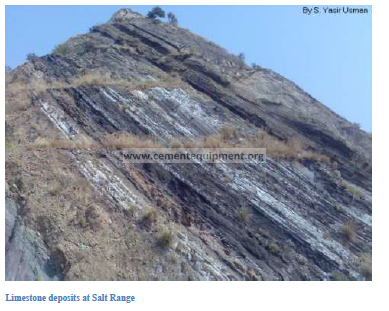
Cement Processing
Cement: A binding material used in construction and engineering, typically made by heating a
mixture of limestone and clay until it almost fuses and then grinding it to a fine powder. When
mixed with water, the silicates and aluminates in the cement undergo a chemical reaction; the
resulting hardened mass is then impervious to water. It may also be mixed with water and
aggregates (crushed stones, sand and gravel) to form concrete
The manufacturing of cement starts with the mining of the raw materials. The larger sized
materials received at the plant are crushed; mix in a proportion and ground to secure a uniform
blend for proper reaction. An intimate mixture usually of limestone and clay or other suitable
materials is subjected from powdered form to solid in a kiln at a temperature of 1400-1500oC for
a certain time. This product called clinker after cooling is ground with 4-6% of gypsum or other
forms of calcium sulphate. The cement is then stored in a tower called silos for shipment in bags
or in bulk.
The cement manufacturing process is an energy consuming process. A substantial amount of
thermal energy is needed in its processing and electrical energy is considerably consumed in the
grinding of raw materials and clinker. Cost of thermal and electrical energy accounts for the
major cost of cement production. Production of one ton of clinker requires the combustion of
about 80-90 liters of heavy oil or 80-100 cubic meters of natural gas or 150-180 kilograms
of coal. An average electric energy consumption for one ton of cement produced in a suspension
kilns is 100-105 kwh, though power consumption from 80 to 85 kwh and even to 70 kwh is
possible with the latest efficient equipment and machinery. A specific fuel consumption of 680-
700 kcal/kg of clinker is being achieved in dry process kilns as against 1400-1500 kcal/kg of
clinker in the earlier wet kilns. Various stages of production are reflected in the functional
diagram given on the next page.
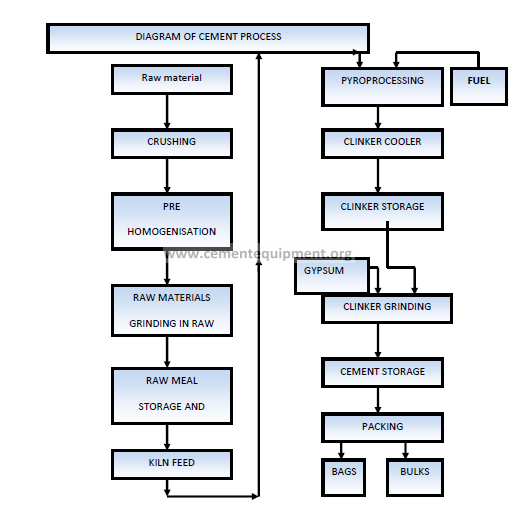
Brief description of the processes is given as under:
Raw Materials
The main raw materials required for cement manufacturing are:
1. Lime stone
2. Clay (Shale)
3. Silica sand
4. Iron ore
5. Gypsum
The main material, limestone, is usually mined on site while the other minor materials may be
mined either on site or in nearby quarries. Another source of raw materials is industrial byproducts.
The use of by-product materials to replace natural raw materials is a key element in
achieving sustainable development .Ordinary Portland cement (Grey Cement) consists of 63% of
calcium oxide. So cement manufacturing plants are usually situated near the deposits of lime
stone and clay. The material used in the manufacturing of Portland cement must contain
appropriate proportion of lime, silica, alumina and iron oxide.
Besides these naturally occurring materials by products of certain industries such as slag, fly ash
and lime mud are also required in the manufacturing of cement.
Requirements of Raw material
About 1500-1600 kg of raw materials is required to produce one ton of Portland cement. The
average amount of materials required to produce one ton of Portland cement are 1.2-1.3 tons of
chalky material like limestone and marl and 0.3-0.4 ton of clay material like shale etc. Besides,
0.05-0.06 tons of natural or synthetic gypsum is required to manufacture one ton of Portland
cement.
Raw Material Preparation
Mining of limestone requires the use of drilling and blasting techniques. The blasting techniques
use the latest technology to insure vibration, dust, and noise emissions are kept at a minimum.
Blasting produces materials in a wide range of sizes from approximately 1.5 meters in diameter
to small particles less than a few millimeters in diameter.
Material is loaded at the blasting face into trucks for transportation to the crushing plant.
Through a series of crushers and screens, the limestone is reduced to a size less than 100 mm and
stored until required.
Depending on size, the minor materials (sand, shale, clay, and iron ore) may or may not be
crushed before being stored in separate areas until required.
The basic raw materials originating from the sources are blasted and crushed. Generally they are
crushed, depending upon their nature, either in primary, secondary or third in order crushers till
they are crushed to the desired size.
Capacity of Crusher and the Quarry Equipment
The quarry and crushing plant is assumed to work either in one or two shifts of 8 hours per day
and 320 days in a year. Primary crushers are commonly designed to operate at 75% of the
available time because of the interruptions in the supply of material, which is unavoidable in
such type of operation.
Raw Grinding
In the wet process, each raw material is proportioned to meet a desired chemical composition and
fed to a rotating ball mill with water. The raw materials are ground to a size where the majority
of the materials are less than 75 microns. Materials exiting the mill are called “slurry” and have
flowability characteristics. This slurry is pumped to blending tanks and homogenized to insure
the chemical composition of the slurry is correct. Following the homogenization process, the
slurry is stored in tanks until required In the dry process, each raw material is proportioned to meet a desired chemical composition and
fed to either a rotating ball mill or vertical roller mill.
The raw materials are dried with waste
process gases and ground to a size where the majority of the materials are less than 75 microns.
The dry materials exiting either type of mill are called “kiln feed”. The kiln feed is pneumatically
blended to insure the chemical composition of the kiln feed is well homogenized and then stored
in silos until required.
Pyro-processing
Whether the process is wet or dry, the same chemical reactions take place. Basic chemical
reactions are: evaporating all moisture, calcining the limestone to produce free calcium oxide,
and reacting the calcium oxide with the minor materials (sand, shale, clay, and iron). This results
in a final black, nodular product known as “clinker” which has the desired hydraulic properties.
In the wet process, the thin liquid cement (slurry) is fed to a rotary kiln, which can be from 3.0 m
to 5.0 m in diameter and from 120.0 m to 165.0 m in length. The rotary kiln is made of steel and
lined with special refractory materials to protect it from the high process temperatures.
Process temperatures can reach as high as 1450oC during the clinker making process.
In the dry process, kiln feed is fed to a pre-heater tower, which can be as high as 150.0 meters.
Material from the pre-heater tower is discharged to a rotary kiln with can have the same diameter
as a wet process kiln but the length is much shorter at approximately 45.0 m. The pre-heater
tower and rotary kiln are made of steel and lined with special refractory materials to protect it
from the high process temperatures.
Regardless of the process, the rotary kiln is fired with an intense flame, produced by burning
coal, coke, oil, gas or waste fuels. Pre-heater towers can be equipped with firing as well
.
The rotary kiln discharges the red-hot clinker under the intense flame into a clinker cooler. The
clinker cooler recovers heat from the clinker and returns the heat to the pyro-processing system
thus reducing fuel consumption and improving energy efficiency. Clinker leaving the clinker
cooler is at a temperature conducive to being handled on standard conveying equipment.
Finish Grinding:
The black, nodular clinker is stored on site in silos or clinker domes until needed for cement
production. Clinker, gypsum, and other process additions are ground together in ball mills to
form the final cement products. Fineness of the final products, amount of gypsum added, and the
amount of process additions added are all varied to develop a desired performance in each of the
final cement products.
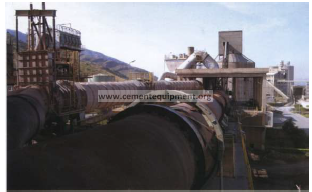
Packing of cement
Cement extracted from the storage towers is fed to the packing machines from where packing in
sacks, bags and in bulk is done. The cement silos have a blower extraction system to reduce
power consumption. Packing machines are of two types i.e stationary packing machine (in-line
packer) having 4-6 filling spouts mounted stationary side by side and rotary packer having 6-16
spouts which are mounted on the bottom of a cylindrical container on a vertical shaft. The
operator puts bags on each spout and opens the valve of the spout into the bag. An electronic
weighing system automatically weighs each sack and controls the filling operation.
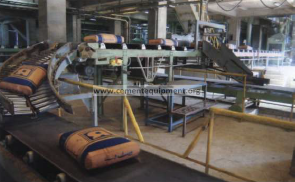
Distribution
Each cement product is stored in an individual bulk silo until needed by the customer. Bulk
cement can be distributed in bulk by truck, rail, or water depending on the customer’s needs.
Cement can also be packaged with or without color addition and distributed by truck or rail.
Growth of Cement Industry in Pakistan
Trends in National Demand
Local demand in the country for the year 2008-09 was estimated at 20 million tons. Domestic
demand is expected to grow at 13% Capacity growth rate (CAGR) during next five years.
National demand of cement is the function of multiple factors. Higher the GDP growth rate is
higher will the demand of cement. The projected GDP growth rate is 4.2%, although a modest
figure, but higher than the GDP rate of 2.4% of the previous year. The demand is expected to rise
in future years. Over the last few years housing sector is registering a steady progress. It accounts
for 40% of cement consumption 5. Over the years the country is growing keen to invest in PSDP
PSDP 2011-12 will be Rs 730 billion (3.4% of GDP), 58% higher than the revised budget of Rs
462 billion of last year6.
Of this national development outlay, federal program is Rs 300 billion – inclusive of ERRA. In
Federal PSDP, highest allocation has been provided to infrastructure, which is 57% of the total
allocation, followed by 42% allocation to the social sectors. It appears heartening but the dark
side of low utilization of funds is equally discouraging. According to verified record of the
ministry of finance, an amount of Rs934.3 billion was allocated for the provinces from 2002-03
to 2010-11 under PSDP but only Rs171.75 billion or 18.4 per cent of it was utilized. The 82% of
funds wet unutilized. Over the last years the country was hit by untoward catastrophes. Heavy
reconstruction work is undergoing the rehabilitate the areas struck by October 5, 2005
earthquake. It is estimated that the reconstruction work has added 4 million tons to the national
demand of cement for the period of 3 to 4 years. Another profitable factor to the industry is
intended construction of the mega dams. Construction of four large dams, namely, Bhasha
Daimer Dam, Munda Dam, Akhori Dam and Neelum Jhelum Hydro Power Project will generate
demand of 3.7mn tons7. In sum, on account of above mentioned factors the demand of cement
will witness a rising trend in future.
Future Outlook of market and international competitors
The global cement market is steadily expanding and it was estimated at 2836 million tons in
20108. Pakistan is a country with modest cement production capacity of 40 million tons. Exports
constitute one third of the national output. Pakistan utilizes 70 to 75 % of its production capacity.
It can comfortably meet any increase in the foreign demand.
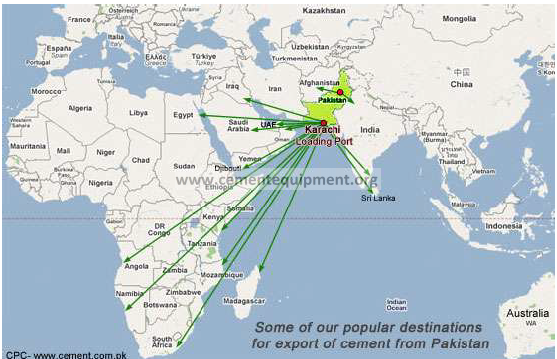
UAE (Dubai), Kuwait, Iraq, Qatar, Djibouti, Afghanistan, South Africa India, Sri Lanka and
other South Asian country are the target destinations of our cement exports. The country
provides Clinker in large quantities to milling units in foreign lands. Many bright opportunities
are coming across Pakistan. The demand is on the rise in the countries of Middle East and
Africa. China and India are themselves large manufacturers of cement but they are suffering
from supply deficit and their markets promises opportunities to our cement industry. The
ongoing trade negotiations will provide additional incentive to our industry to export cement to
India. FIFA 2014 Football World Cup will be held in South Africa and she is considering cement
products of Pakistan for the construction of stadiums. The demand of Pakistan origin cement will
also be supported by closing down of some cement units in Europe due to their strict laws
governing pollution control and other environment hazards. Pakistan having many big cement
units and large reserves of raw material, the import of Cement from Pakistan will be the prime of
choice of the International buyers all over the world
Contribution of the Industry to the country’s Economy
Creation of Employment
The industry accounts for 3 % of the employed force of the country. The employed force is the
mix of labor, technicians and the management and engineering professionals. The industry is in
locations that are distant from populated areas. It provides residence, education and health
facilities to its employees. It generates employment opportunities for the connected industries
particularly transport industry and small retailers.
Tax Revenue
The industry accounts for Rs. 30 billion tax revenue to the country. Last four years experienced
four billion rupees investment in the development of cement industry. The industry is expanding
the tax revenue will rise in future. The industry also affords profitable opportunities to foreign
investors. At present, four foreign companies are operating in the country.
Challenges:
High cost of energy:
The importance of cost of energy can be realized from the fact that cost of energy constitutes
over 50 percent of cost of production of cement.
Cost of power has increased by 9 per cent in last three months it increases from Rs 7.1 per KWH
to Rs 7.7 per KWH. The situation is worsening with further increase in power tariff that is
anticipated to be Rs 3.04 per KWH.10
Rates of diesel have been increased by 15 per cent in the first quarter of FY 2012.
Rates of coal have been increased by 8 per cent. the coal utilized by Pakistan cement industry is
mostly imported from Australia. Due to recent catastrophic floods and heavy rains it is expected
that Australia will further increase rates of coal.
Rates of furnace oil have been increased by 28 per cent in first quarter of financial year 2012.
Heavy taxation:
Presently cement industry is paying RS 800 per ton as Federal Excise Duty 16 per cent as GST
which approximately is Rs 750 per ton. Further royalty of Rs 10 per ton is paid to provincial
government for using limestone. PSQCA is charging Rs 5 to 6 as marking fee. A number of
cement manufacturers have become defaulters by non payment of this marking fee, APCMA
considers this marking fee unjust and burden on the manufacturers who are already victims of
heavy taxation -one of the highest in the region
High freight charges:
A public notice was issued by government of Pakistan on 26th of March 2010 that 35 per cent of
inland freight was allowed till 30th June 2010, based on this public notice the cement
manufacturers exported large quantum of cement, but unfortunately not a single claim has been
entertained till date. It is proving to be mayhem for cement manufacturers as lump sum amount
on stake.12
8.4 Low spending upon PSDP
There is a strong positive correlation between increase in local cement dispatches and PSDP
allocation. The cement demand grew 19 percent and 13 percent during FY05 and FY06
respectively. During the first nine months of FY07-08, production increased by 30 percent as
compared to 2010.The demand for cement was forecasted to grow by 26 percent during FY07
and 17 percent inFY08. The per capita consumption of cement has risen from 117 kg in FY06 to
131 kg in FY07.The main factors behind increase in demand of cement were:
o 60 percent higher
Public Sector Development Projects (PSDP) allocation,
o seven percent
GDP growth,
o increasing
number of real estate development projects for commercial and residential use,
o developing
export market and
o expected
construction of mega dams.
The operating capacity of cement in FY05 and FY06 was18 million and 21million tonnes, which
rose to 37 million tonnes by the end of FY07.The cement manufacturers added eight million
tonnes to the capacity and the total production was expected to be 45 million tonnes by the end
of 2010.
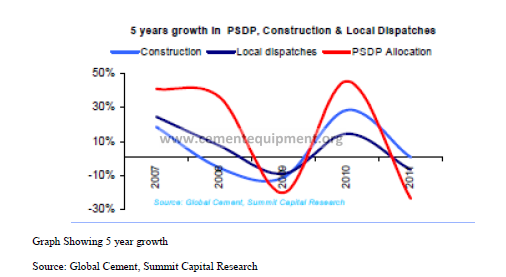
The reduction in PSDP fund due to cuts in expenditure by the Government proved to be a bad
omen for the industry . All the cement plants are running at just 50 per cent production capacity
despite the fact that more plants have been installed. The domestic demand for cement has
witnessed significant reduction of 10-15 per cent during FY 2010. The massive cut in Public
Sector Development Program in the last two years has reduced the local demand for the
commodity and has forced several enterprisers to seriously think to either reduce their operations
or close the plants as most of them are not even have enough liquidity to service their debts.
Local dispatches are expected to rise by 6 per cent in FY12 on the back of higher PSDP spending
and reconstruction activities in the flood hit areas.
Cartels and Efficiency
The sharp decline in cement prices due to domestic competition among producers dampened the
profitability of the industry. To cope with this situation the manufacturers had strengthened the
cartel to set minimum cement prices. The example was marketing arrangement that increased
cement prices to the extent of 20 percent despite coal prices have gone down in the international
market to $124 from nearly $ 140 in November 2007 to January 2008.To break-up cartel the
Competition Commission of Pakistan raided the offices of Association of Cement Manufacturers
of Pakistan and confiscated computers and office record. The association condemned this action
and said it is against business norms. They said the commission is blaming cement
manufacturers for making a cartel for the last 10 years but could not able to prove it.
Fluctuating Interest rates
Investors are shying away from investments in Construction and real estate due to fluctuating
interest rates. So there is a slump in this sector causing lower domestic demand for cement.
Pakistan is the fifth largest exporter of cement. Pakistan exports cement to Afghanistan, India,
Africa, Iran and Saudi Arabia other Middle Eastern countries.
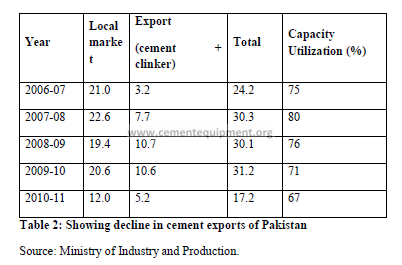
Pakistan’s cement exports have faced decline because Saudi Arabia , India and Iran are
converting from dependent importers to potential competitors.
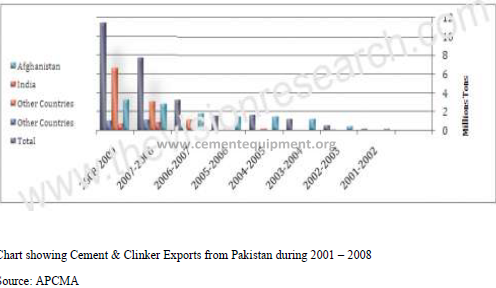
Secondly, Pakistan cement export to Afghanistan and India has been declined by $20 Million in
first half of current Fiscal Year. Afghanistan has increased transit fee by 100% on behest of
Indian business men, as they are eyeing Afghanistan as there potential exporters. Transit fee
before this increment was Rs 9000 per truck which has been increased to Rs 18000 per truck.
Exports to India has been reduced because of Indian authorities refusal to renew export licenses
of some of the Pakistan’s manufacturers
Stagnant domestic consumption:
The local consumption of cement is stagnant for last several years because of which cement
industry is utilizing 50% of its production capacity .Local consumption is 22 million tons per
year for last three years against the production capacity of 43 Million tons
Cement consumption declined by 8.24 % during FY2010-11 as compared to last year. Decrease
in capacity utilization was at its lowest at 76.12 % in past 8 years with total dispatches declining
by 6.68 % to 22.97 Million tons, down from 23.55 Million tons in 2009-1017
Low consumption of cement mirrors the low growth of economy:
GDP & Cement consumption
“The economy has considerably lost significant growth momentum during last three years as the
economic growth averaged just 2.6 percent as against 5.3 percent in preceding 8 years”.
(Economic survey of Pakistan 2010-11)
Lower GDP & Lower cement consumption.
Secondly government has decreased its developmental spending due to devastating floods of
2010, rehabilitation of IDPs, security issues, War against terrors and extreme conditionality from
IMF resulted in decreased cement utilization in domestic market
Challenges to the northern zone:
The cement industry remained particularly challenged and under pressure in the northern part of
the country.
a) decrease in despatches: The 19 cement units in the northern region have a cumulative
production capacity of 36.17 million tons. These units dispatched only 17.892 million ton of
cement in FY2010-11 which was less than 50 per cent of their potential capacity. In 2009-10
these units dispatched 11.22 per cent more cement amounting to 20.154 million tons.
b) high cost of transportation: Export via sea is not feasible for the large number of mills in
the north due to high transportation cost.
c) Law and order issues in the north: may also have impacted the sales of cement
adversely.
) reduction in local demand in north: The woes of the plants based in the north were
compounded by reduction in domestic demand in northern parts of the country
Swot analysis:
Strengths:
1. The country is rich in the raw material necessary for the manufacturing of cement.
2. Over the years, huge investments were made in the industry. The industry commands
sophisticated infrastructure particularly machinery imported from the various developed
countries. It adds to the capacity of the industry to manufacture good quality cement.
3. The installed capacity of the country is 40 million tons. The capacity utilization stands
between 70% to 75%. The exports constitutes one third of the nation cement output. The
industry can comfortably meet any increase in the national demand as well as foreign
demand.
4. The country affords an attractive opportunity to foreign investors. The country abounds
in raw materials and also experiencing a growth in the construction industry. The country
also intends to take on mega projects e.g. construction of mega dams. Already, there are
operating four foreign companies in the country. Cement manufacturing is a profitable
business in Pakistan.
5. Local demand in the country for the year 2008-09 was estimated at 20 million tons.
Domestic demand is expected to grow at 13% Capacity growth rate (CAGR) during next
five years. Housing societies are mushrooming in the country. The government of Punjab
has taken on the Ashiayana Housing Project. The housing sector consumes 40% of
cement output. The cement industry is expected to rise.
6. The energy consumption by the industry is high. The prices of oil, gas and electricity are
increasing steadily over the years. It will take a high toll upon the industry if the situation
persists but the government is keen to increase the supply of electricity and reduce its
dependence upon the oil. The country also abounds in coal reserves which will prove a
cheap source of energy to the cement industry.
7. The industry exports cement to various countries of Central Asia, Africa and Middle
East. The country carries a good infrastructure of raw materials and machinery. It can
improve upon its international market share.
Weaknesses
1. The industry operates under certain discouraging conditions. The prominent among them
is the high cost of energy that renders our cement product less competitive. Over the past
years, the prices of oil, gas and electricity have undergone a sharp increase thus,
increasing the cost of manufacturing cement.
2. The industry is heavily taxed and it results in high prices. High prices of cement will
impair the growth of housing sector as well as government capacity to initiate mega
projects.
3. The industry has acquired the shape of an oligopoly or a cartel. Cartelization adversely
affects the efficiency of an industry. It dents the ability of the industry to improve upon
its processes, management skills and pricing. This sorry state will rob the country of its
share in international market in the long run.
4. Pakistan is a struggling economy where development activities stand at a modest level.
Over the last eight years, the GDP growth rate averaged at 2.6%. The issue of terrorism
has impaired the government capacity to concentrate upon development projects. The
local consumption of cement is stagnant for last several years because of which cement
industry is utilizing 50% of its production capacity .Local consumption is 22 million tons
per year for last three years against the production capacity of 43 Million tons.
5. The industry is a profit generating industry in the Pakistan. Cement industry is a capital
intensive industry but the poor law and order conditions in the country discourage the
foreign investor to invest in Pakistan.
6. The cost of manufacturing cement is high in the country. One of the factors of high cost
is the high freight charges. The cost of transportation is equally high. Inflation is injuring
the industry severely.
Opportunities
1. The country is undergoing energy crisis. It is seriously considering coal as a substitute for
oil and gas. It will provide the cement industry a cheap and a constant source of energy.
The country abounds in coal reserves. The coal will allow the cement industry an
opportunity to reduce its cost of manufacturing cement.
2. The industry expects increased demand in the coming years. The government intends to
construct dams and provide housing provision to its people.
3. The industry expects increased exports targeted to Middle Eastern countries. These
countries are thriving economies and are undertaking massive construction activities.
4. The new port of Gwadar carries a promise of increased exports of our products. It is
strategically located close to Gulf countries. It has been declared duty free by the
government. It will help to promote the export of our cement products.
Threats
1. The cement industry is a capital intensive industry. The interest rate of 12.5%
discourages the growth of industry. Furthermore, the interest rates fluctuate
regularly in the country. This condition of uncertainty is threat to the industry.
2. The economy of the country is confronted with many problems. The country
expects a low GDP growth rate in the current financial year. The development
activities are the function of growing economies. Absence of development
activities will damage the cement industry.
3. Exports of cement are equal to the one third of national output of cement. It is
feared that our share of market will erode as our products are turning less
competitive on account of high cost of production. The industry exists in the form
of cartel thus, suffering from inertia to innovate and to improve upon its
production skills. The countries of Iran and India have a strong potential to snatch
our share of international market.
4. The industry is heavily dependent upon fuel. Oil is a precious as well as imported
commodity. Any disruption in the supply of oil can jeopardize the working of
cement industry in the country.
Analysis and Recommendations
The industry operates under a mix of unfriendly conditions and threats. The industry can defeat
these threats by exploiting its strengths and emerging opportunities.
1. Fuel constitutes the 40% of the cost but the large reserves of coal in the country afford
the industry a chance to arrange a cheap and constant source of energy for production.
The government needs to tap coal reserves and make it available for industrial
consumption.
2. The industry suffers from heavy taxation and it contributes 30 billion rupees in the form
of taxes. It commands good bargaining power and it can mount pressure upon the
government for favorable taxation of the industry. The import of cement machinery
should be exempt from the levy of sales tax. The government also needs to review FED
upon the manufacturing of cement products
.
3. The industry exists in the form of cartel. Cement is capital intensive industry. Over the
years banking sector has registered a splendid progress. These days, new entrants can
enter into the cement business by availing credit facilities by banks. It will help set in
efficiency and healthy competition in the cement industry. The government needs to
reduce the interest rates in the interest of the industry.
4. The country commands good diplomatic ties with Middle Eastern countries. It a partner
in the ‘War on Terrorism’. It can exploit its diplomatic relations and seek trade
concessions for the cement industry.
5. The government can stimulate the export of cement by promoting its cement products at
exhibitions arranged by Trade Development Authority of Pakistan.
6. The Competition Commission of Pakistan needs to intervene and change the oligopolistic
character of the industry. In the environment of competition and efficiency, the industry
will grow mature and it will fare well in the international market.
7. The industry affords a good opportunity of generating profit to the foreign investors. By
raising good law and order conditions and an efficient judicial system the government
can attract foreign investors to invest in the country.
8. The growth of every industry is the function of progressive economy. By stimulating
economic growth and taking on development projects the government can uplift the
condition of cement industry in the country.
Annexure 1: Showing a step wise diagram of the cement manufacturing process
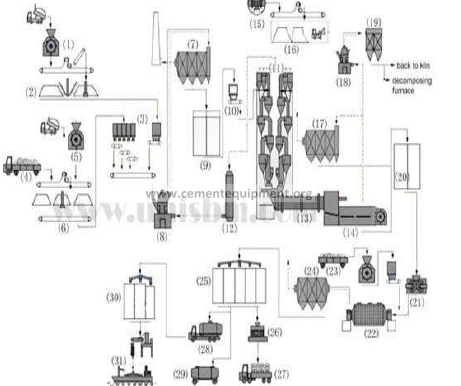
1) Limestone crusher
2) Limestone pre-homogenizing
yard
3) Batch calculation
4) Additive
5) Crusher
6) Additive yard
7) Dust collection
8) Raw mill
9) Homogenization silo
10) Feeding calculation
11) Pre-heater
12) Humidifier tower
13) Rotary kiln
14) Cooler
15) Raw coal
16) Coal yard
17) Electric precipitator
18) Coal mill
19) Burgy precipitator
20) Clinker silo
21) High pressure grinding roll
22) Ball mill
23) Gypsum
24) Concrete precipitator
25) Concrete storage
26) Packer
27) car stowage
28) car loader
29) train stowage
30) port silo
31) bulk concrete